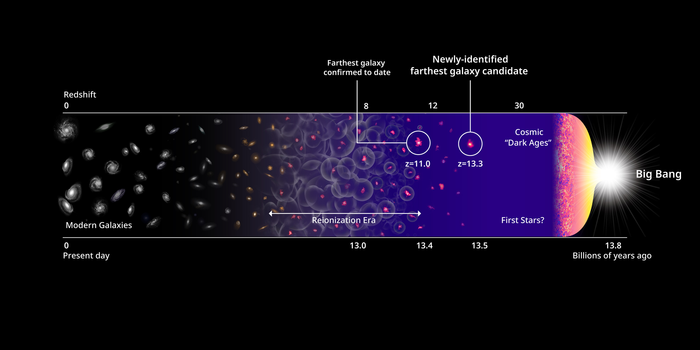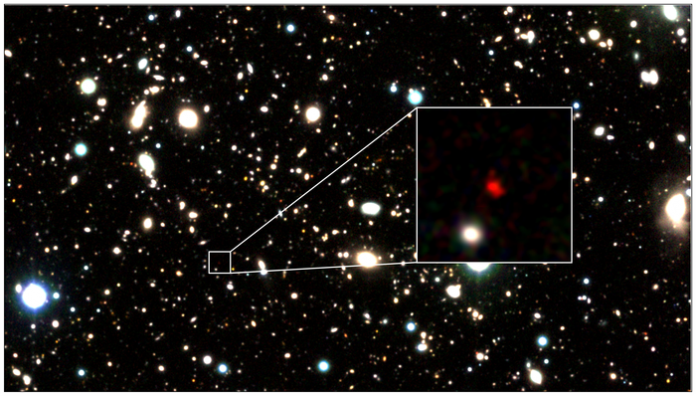A team from the Centre for Astrophysics, Harvard & Smithsonian, have spotted the most distant astronomical object ever: A galaxy
The galaxy candidate named HD1 is some 13.5 billion light-years away. It is already raising questions in the scientific community, as to what the galaxy is and what it contains.
These findings are shown in Monthly Notices of the Royal Astronomical Society Letters.
There are two theories surrounding the newly discovered HD1
Speculation surrounding HD1 is rife, the team from MNRAS have been able to put forward two proposals for what HD1 might be:
- Hd1 may be forming stars at an astounding rate and is now possibly home to Population III stars – the universe’s very first starts – which up until now have never been scientifically observed
- Hd1 may contain a supermassive black hole about 100 times the mass of our sun
Fabio Pacucci, lead author of the MNRAS study, co-author in the discovery paper on ApJ, and an astronomer at the Centre for Astrophysics said: “Answering questions about the nature of a source so far away can be challenging, It’s like guessing the nationality of a ship from the flag it flies, while being faraway ashore, with the vessel in the middle of a gale and dense fog.
“One can maybe see some colours and shapes of the flag, but not in their entirety. It’s ultimately a long game of analysis and exclusion of implausible scenarios.”

HD1 may not be forming normal, everyday stars
According to researchers, HD1 is extremely bright when viewed under ultra violet light, due to “some energetic processes that are occurring there or, better yet, did occur some billions of years ago,” Pacucci says.
Assumptions and predictions surrounding the new galaxy have been common, researchers explains that at first, HD1 was presumed to be a standard starburst galaxy that was creating stars at a high rate.
However after calculating how many stars HD1 was producing, they obtained: “an incredible rate — HD1 would be forming more than 100 stars every single year. This is at least 10 times higher than what we expect for these galaxies.”
This appears to be when the team began suspecting that HD1 might not be forming normal, everyday stars.
There is the possibility of a supermassive black hole
“The very first population of stars that formed in the universe were more massive, more luminous and hotter than modern stars,” Pacucci says. “If we assume the stars produced in HD1 are these first, or Population III, stars, then its properties could be explained more easily. In fact, Population III stars are capable of producing more UV light than normal stars, which could clarify the extreme ultraviolet luminosity of HD1.”
A supermassive black hole, however, could also explain the extreme luminosity of HD1. As it absorbs enormous amounts of gas, high energy photons may be emitted by the region around the black hole. If this is the case, it would made HD1 the earliest supermassive black hole known to human kind – observed to be much close in time to the Big Bang compared to the SMB current record holder. “HD1 would represent a giant baby in the delivery room of the early universe,” says Avi Loeb an astronomer at the Center for Astrophysics and co-author on the MNRAS study.
“HD1 would represent a giant baby in the delivery room of the early universe,” says Avi Loeb an astronomer at the Center for Astrophysics and co-author on the MNRAS study.
“It breaks the highest quasar redshift on record by almost a factor of two, a remarkable feat.”
HD1 was discovered after more than 1,200 hours of observing time with the Subaru Telescope, VISTA Telescope, UK Infrared Telescope and Spitzer Space Telescope.
Using the James Webb Space Telescope to look further
Using the James Webb Space Telescope, the research team will soon once again observe HD1 to verify its distance from Earth.
If current calculations prove correct, HD1 will be the most distant — and oldest — galaxy ever recorded.
“Forming a few hundred million years after the Big Bang, a black hole in HD1 must have grown out of a massive seed at an unprecedented rate,” Loeb said.
“Once again, nature appears to be more imaginative than we are.”











